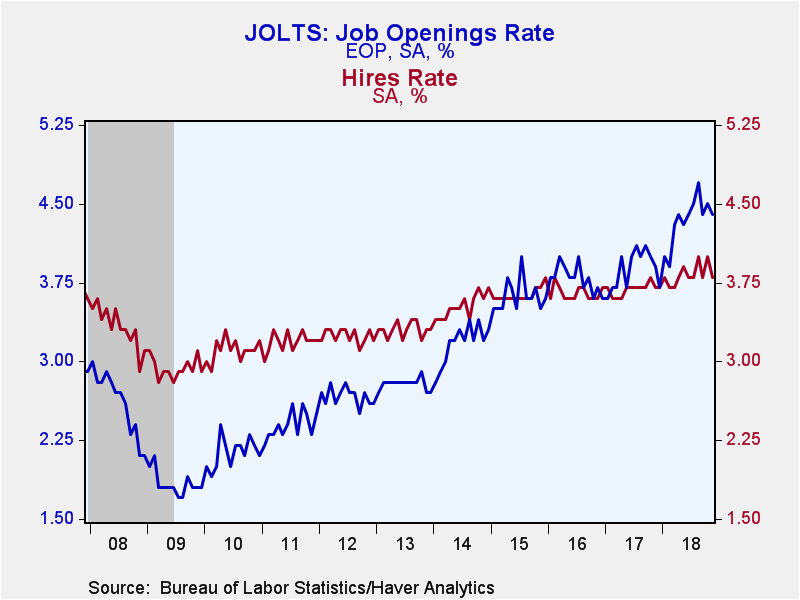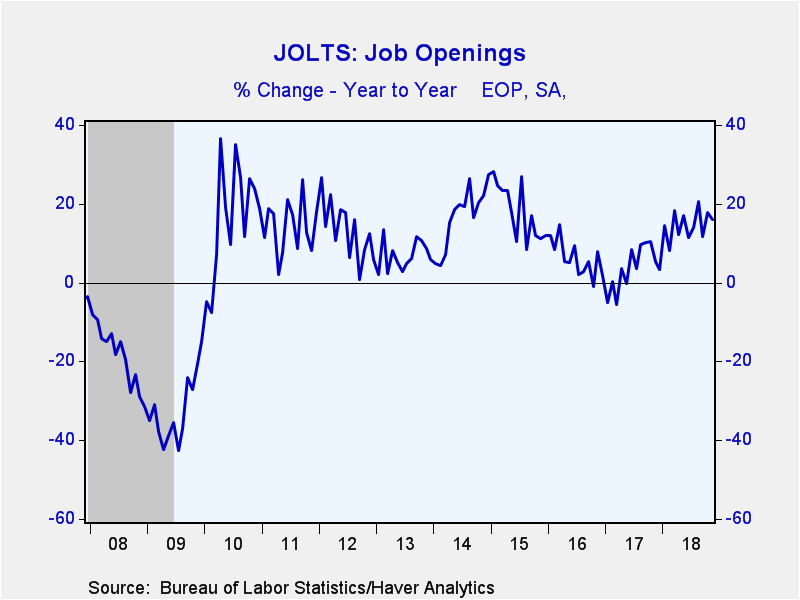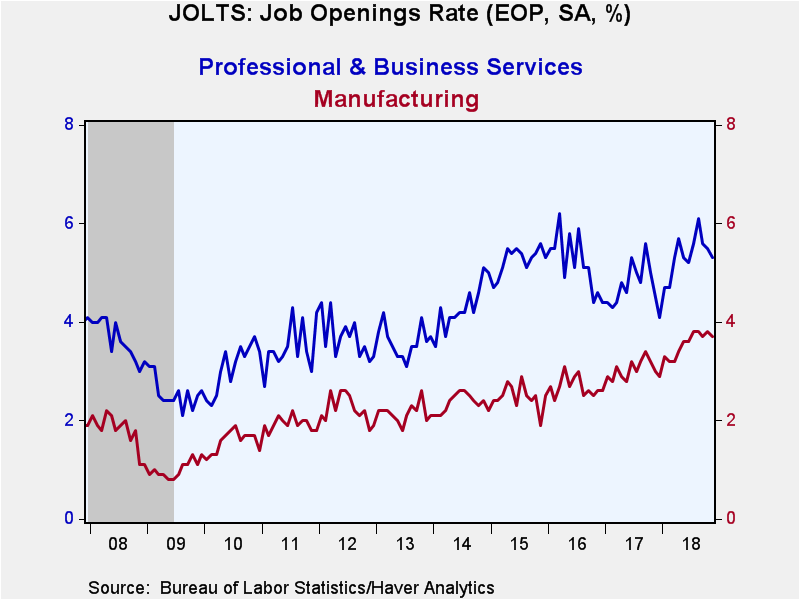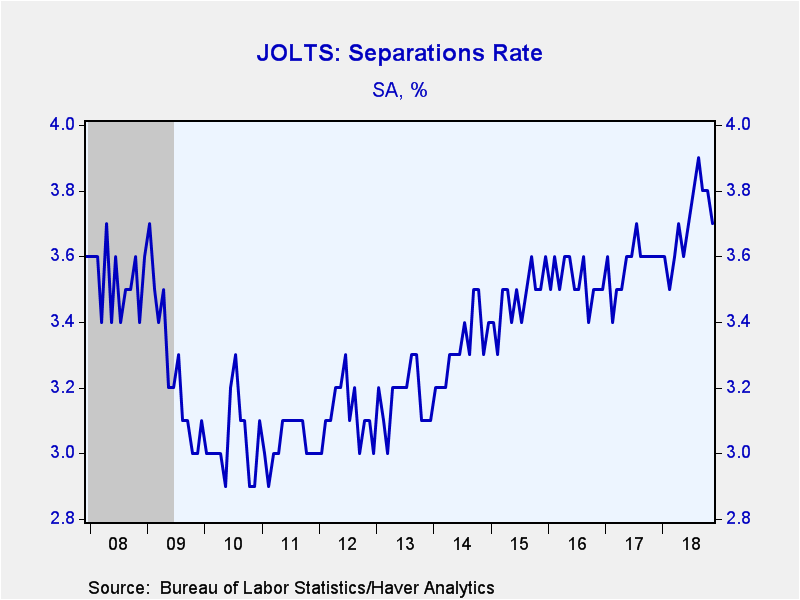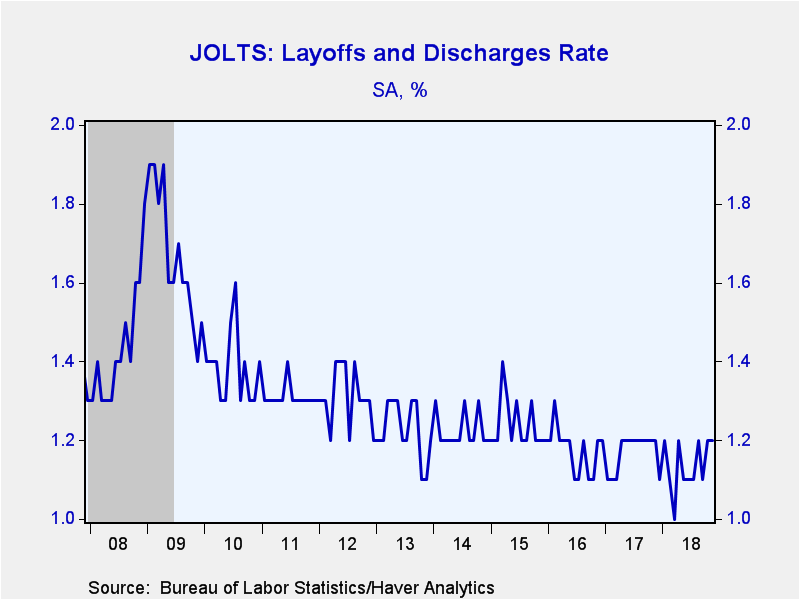 Global| Jan 08 2019
Global| Jan 08 2019U.S. JOLTS: Job Openings and Hires Rates Slip
by:Tom Moeller
|in:Economy in Brief
Summary
The Bureau of Labor Statistics reported that the total job openings rate eased to 4.4% during November, retracing its October gain to 4.5%. The job openings rate is the job openings level as a percent of total employment plus the job [...]
The Bureau of Labor Statistics reported that the total job openings rate eased to 4.4% during November, retracing its October gain to 4.5%. The job openings rate is the job openings level as a percent of total employment plus the job openings level. The hiring rate slipped to 3.8% and retraced its October rise. The layoff & discharge rate held steady at 1.2%, still above the record low of 1.0% reached in March, and the quits rate held steady at 2.3%, just below the record high. The JOLTS data begin in 2000.
The private-sector job openings rate eased to 4.7% and remained below the record high of 4.9%. In leisure & hospitality, the rate eased to 5.7%. In professional & business services, it declined to 5.3%, though that remained up versus a low of 4.1% in December. In education & health services, the rate increased to a strong 5.1%, and in trade, transportation & utilities, it eased to 4.4%. The rate declined to 3.7% in construction, and in manufacturing, it slipped to a near-record 3.7%. The job openings rate in government held steady at 2.7%, but remained up sharply versus the 2009 low of 1.2%.
The level of job openings declined 3.4% in November (+16.1% y/y) to 6.888 million. Private-sector openings fell 3.6% m/m but were up 15.5% y/y. Construction sector job availability surged by another one-quarter y/y. Openings in leisure & hospitality strengthened by 16.0% y/y and they rose to the same degree y/y in education & health services. Openings also rose by one-quarter y/y in manufacturing. Trade, transportation & utilities job openings increased by 7.4% y/y. Job openings in professional business services gained an improved 20.5% y/y and they rose 16.0% y/y in leisure & hospitality. Government sector job openings rose roughly one-quarter y/y.
The private-sector hiring rate eased to 4.2% from October's 4.4%, but remained just below August's eleven-year high of 4.4%. The rate in leisure & hospitality fell to 6.4%, and in professional & business services, it declined to 4.9%. The construction sector's hiring rate improved to 5.2%, but remained down from the January 2017 high of 5.8%. The hiring rate in trade, transportation & utilities fell to 4.1%, still up sharply from last year's low of 3.6%. In education & health services, the rate held steady at 3.2%. In manufacturing, the rate was little-changed at 2.9%. The hiring rate in government held steady at 1.6%.
Total hiring declined 3.7% (+3.7% y/y) to 5.710 million, reversing the October increase to a record high. Hiring in the private sector rose 3.7% y/y with trade, transportation & utilities hiring strengthening 8.9% y/y. Factory-sector hiring rose 9.9% y/y. Educational & health services hiring jumped 11.1% y/y and leisure & hospitality improved 2.1% y/y. Construction sector hiring rose 6.2% y/y, but professional & business employment declined 9.4% y/y. Government sector hiring rose 4.0% y/y.
The overall job separations rate eased to 3.7%, but remained near the expansion high. The private sector separations rate slipped to 4.0%, down versus its cycle high of 4.3% reached in August. The separations rate in government held steady at 1.6%.
The level of overall separations strengthened 4.8% y/y to 5.507 million, though the level has fallen recently. In the private sector, they were up 5.0% y/y led by a 10.8% y/y surge in trade, transportation & utilities. Leisure & hospitality job separations increased 4.5% y/y and in manufacturing, they rose 12.0% y/y. In the financial sector, they increased 13.3%. Separations in construction fell 8.4% y/y and education & health services separations rose 13.7% y/y. Separations in the information sector gained 12.3% y/y. Professional & business services job separations decreased 12.3% y/y. Separations in the government sector gained 2.8% y/y.
The level of quits declined 3.2% m/m (+6.6% y/y) to 3.407 million in November. The quits rate held steady m/m at 2.3%, but it remained up sharply from 1.3% at the beginning of the expansion. The private-sector quits rate declined to 2.5%. The rate eased in leisure & hospitality to 4.2% and in education & health services, it increased to 2.2%. In the financial sector, it was 1.1% and in professional & business services, the rate declined to 2.7%. In the factory sector, it rose to 1.8% which was up from 0.6% 2009 low. The government sector quit rate was little changed m/m at 0.9%, which was double the expansion low.
The level of layoffs increased 2.0% y/y to 1.769 million, leaving the layoff rate unchanged at 1.2%, nearly the record low. In the private sector, the layoff rate held steady at 1.3%, down from the 2009 high of 2.2%. The professional & business services rate slipped to 1.8%, while in the information sector, it was steady at 0.7%. In leisure & hospitality, the layoff rate remained high at 1.7% and in the factory sector, it slipped to 0.9%. The government sector layoff rate held steady at 0.5%.
The Job Openings & Labor Turnover Survey (JOLTS) survey dates to December 2000 and the figures are available in Haver's USECON database.
| JOLTS (Job Openings & Labor Turnover Survey, SA) | Nov | Oct | Sep | Nov'17 | Nov'16 | Nov'15 |
|---|---|---|---|---|---|---|
| Job Openings, Total | ||||||
| Rate (%) | 4.4 | 4.5 | 4.4 | 3.9 | 3.7 | 3.5 |
| Total (000s) | 6,888 | 7,131 | 6,960 | 5,931 | 5,931 | 5,335 |
| Hires, Total | ||||||
| Rate (%) | 3.8 | 4.0 | 3.8 | 3.7 | 3.6 | 3.7 |
| Total (000s) | 5,710 | 5,928 | 5,696 | 5,505 | 5,279 | 5,324 |
| Layoffs & Discharges, Total | ||||||
| Rate (%) | 1.2 | 1.2 | 1.1 | 1.2 | 1.2 | 1.2 |
| Total (000s) | 1,769 | 1,761 | 1,707 | 1,734 | 1,693 | 1,699 |
| Quits, Total | ||||||
| Rate (%) | 2.3 | 2.3 | 2.4 | 2.2 | 2.1 | 2.0 |
| Total (000s) | 3,407 | 3,519 | 3,564 | 3,195 | 3,022 | 2,892 |
Tom Moeller
AuthorMore in Author Profile »Prior to joining Haver Analytics in 2000, Mr. Moeller worked as the Economist at Chancellor Capital Management from 1985 to 1999. There, he developed comprehensive economic forecasts and interpreted economic data for equity and fixed income portfolio managers. Also at Chancellor, Mr. Moeller worked as an equity analyst and was responsible for researching and rating companies in the economically sensitive automobile and housing industries for investment in Chancellor’s equity portfolio. Prior to joining Chancellor, Mr. Moeller was an Economist at Citibank from 1979 to 1984. He also analyzed pricing behavior in the metals industry for the Council on Wage and Price Stability in Washington, D.C. In 1999, Mr. Moeller received the award for most accurate forecast from the Forecasters' Club of New York. From 1990 to 1992 he was President of the New York Association for Business Economists. Mr. Moeller earned an M.B.A. in Finance from Fordham University, where he graduated in 1987. He holds a Bachelor of Arts in Economics from George Washington University.


